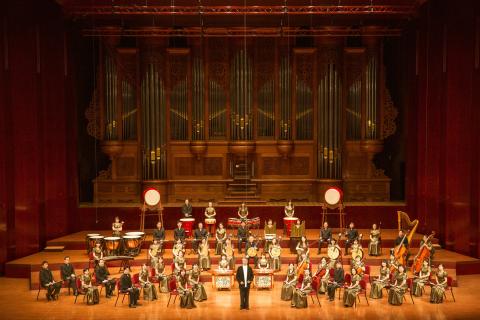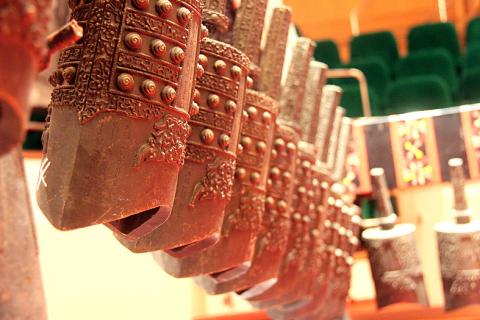The bianzhong (編鐘) is an ancient Chinese musical instrument consisting of 65 chime bells. Because it was only used for performances at the imperial court, it came to be known as the “instrument of kings” (王者之器).
The National Chinese Orchestra Taiwan (NCO, 台灣國樂團) has teamed up with the China’s Chinese Chime Bells Orchestra of Hubei (中國湖北編鐘國樂團) for When Bianzhong meets Organ (當編鐘遇上管風琴), a concert at the National Concert Hall (國家音樂廳) that brings together the melodies of the bianzhong with what Wolfgang Amadeus Mozart considered to be the king of musical instruments: the organ.
Conductor Yan Huichang (閻惠昌) who last year took over as NCO’s principal guest conductor, devised the repertoire to showcase original combinations between the two majestic instruments, and between early and modern Chinese musical instruments.

Photo courtesy of NTCH
GOING THROUGH TIME
The bianzhong used by the Hubei orchestra is a replica of a full set discovered in a state of near perfect preservation in the royal tomb of Marquis Yi of Zeng (曾侯乙), dating to the Warring States period, in present day Hubei Province. The 1978 excavation was important because it provided archeologists with a clearer understanding of ancient court musical practices.
Each bell produced two different musical notes, of a slightly different musical scale to Western music, depending on where they were struck. The twin-tone capability allows it to complete a 12-tone scale, Yan said.

Photo courtesy of NTCH
Yan said that the pitch of the replica bianzhong is slightly different because it has been tuned in a way suited to contemporary musical instruments and orchestral performances.
The bells are typically arranged on three wooden frames according to their pitches, which requires a meticulous process of assembling and dismantling.
The replica includes 65 bronze chime bells and weighs over six tons.

Photo courtesy of NTCH
“It takes 15 to 20 trained people two hours to install the bells,” Yan said.
Wang I-yu (王乙聿) will perform Majestic Demeanor (王者之聲), a new piece he wrote for pipe organ.
“On the one hand, Wang’s work delivers a robust contrast between bianzhong and organ; yet at some points, the two complement each other in harmony,” Yan said.
In addition to Wang’s work, the concert will stage five other compositions, such as German composer Robert Zollitsch’s Resounding Chimes. Zollitsch, who goes by the name Lao Luo (老鑼), visited the Hubei museum to study the timbre and performing techniques of the chime bells first hand.
“Lao Luo’s piece employs nearly all 65 chime bells, which needs 13 performers to play. The extensive use of the bells brings bianzhong music to another level,” Yan said.
When Bianzhong meets Organ is a part of the Taiwan International Festival of Arts (台灣國際藝術節), which began earlier this month.

US President Donald Trump may have hoped for an impromptu talk with his old friend Kim Jong-un during a recent trip to Asia, but analysts say the increasingly emboldened North Korean despot had few good reasons to join the photo-op. Trump sent repeated overtures to Kim during his barnstorming tour of Asia, saying he was “100 percent” open to a meeting and even bucking decades of US policy by conceding that North Korea was “sort of a nuclear power.” But Pyongyang kept mum on the invitation, instead firing off missiles and sending its foreign minister to Russia and Belarus, with whom it

Many people noticed the flood of pro-China propaganda across a number of venues in recent weeks that looks like a coordinated assault on US Taiwan policy. It does look like an effort intended to influence the US before the meeting between US President Donald Trump and Chinese dictator Xi Jinping (習近平) over the weekend. Jennifer Kavanagh’s piece in the New York Times in September appears to be the opening strike of the current campaign. She followed up last week in the Lowy Interpreter, blaming the US for causing the PRC to escalate in the Philippines and Taiwan, saying that as

When Taiwan was battered by storms this summer, the only crumb of comfort I could take was knowing that some advice I’d drafted several weeks earlier had been correct. Regarding the Southern Cross-Island Highway (南橫公路), a spectacular high-elevation route connecting Taiwan’s southwest with the country’s southeast, I’d written: “The precarious existence of this road cannot be overstated; those hoping to drive or ride all the way across should have a backup plan.” As this article was going to press, the middle section of the highway, between Meishankou (梅山口) in Kaohsiung and Siangyang (向陽) in Taitung County, was still closed to outsiders

The Chinese Communist Party (CCP) has a dystopian, radical and dangerous conception of itself. Few are aware of this very fundamental difference between how they view power and how the rest of the world does. Even those of us who have lived in China sometimes fall back into the trap of viewing it through the lens of the power relationships common throughout the rest of the world, instead of understanding the CCP as it conceives of itself. Broadly speaking, the concepts of the people, race, culture, civilization, nation, government and religion are separate, though often overlapping and intertwined. A government